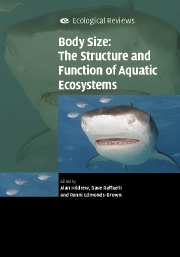Book contents
- Frontmatter
- Contents
- List of contributors
- Preface
- 1 The metabolic theory of ecology and the role of body size in marine and freshwater ecosystems
- 2 Body size and suspension feeding
- 3 Life histories and body size
- 4 Relationship between biomass turnover and body size for stream communities
- 5 Body size in streams: macroinvertebrate community size composition along natural and human-induced environmental gradients
- 6 Body size and predatory interactions in freshwaters: scaling from individuals to communities
- 7 Body size and trophic cascades in lakes
- 8 Body size and scale invariance: multifractals in invertebrate communities
- 9 Body size and biogeography
- 10 By wind, wings or water: body size, dispersal and range size in aquatic invertebrates
- 11 Body size and diversity in marine systems
- 12 Interplay between individual growth and population feedbacks shapes body-size distributions
- 13 The consequences of body size in model microbial ecosystems
- 14 Body size, exploitation and conservation of marine organisms
- 15 How body size mediates the role of animals in nutrient cycling in aquatic ecosystems
- 16 Body sizes in food chains of animal predators and parasites
- 17 Body size in aquatic ecology: important, but not the whole story
- Index
- References
3 - Life histories and body size
Published online by Cambridge University Press: 02 December 2009
- Frontmatter
- Contents
- List of contributors
- Preface
- 1 The metabolic theory of ecology and the role of body size in marine and freshwater ecosystems
- 2 Body size and suspension feeding
- 3 Life histories and body size
- 4 Relationship between biomass turnover and body size for stream communities
- 5 Body size in streams: macroinvertebrate community size composition along natural and human-induced environmental gradients
- 6 Body size and predatory interactions in freshwaters: scaling from individuals to communities
- 7 Body size and trophic cascades in lakes
- 8 Body size and scale invariance: multifractals in invertebrate communities
- 9 Body size and biogeography
- 10 By wind, wings or water: body size, dispersal and range size in aquatic invertebrates
- 11 Body size and diversity in marine systems
- 12 Interplay between individual growth and population feedbacks shapes body-size distributions
- 13 The consequences of body size in model microbial ecosystems
- 14 Body size, exploitation and conservation of marine organisms
- 15 How body size mediates the role of animals in nutrient cycling in aquatic ecosystems
- 16 Body sizes in food chains of animal predators and parasites
- 17 Body size in aquatic ecology: important, but not the whole story
- Index
- References
Summary
Introduction
This chapter demonstrates how investigating patterns of survival, reproduction, growth and development – life histories – can improve understanding and prediction in diverse areas of ecology ranging from microevolution and population dynamics of individual species, to ecosystem function and biogeochemistry.
To make sense of the huge diversity of life history in nature, a first step is to derive a common set of traits, such as age and size at first reproduction, number and size of offspring, inter-clutch interval, and juvenile and adult survival. The effects of changes in the magnitude of each of these traits on the others (e.g. increased offspring size may be traded off against a reduction in offspring number), and their relationship to fitness or population growth under particular environmental conditions, can then be analyzed.
This chapter initially outlines how this process, life-history analysis, is used in adaptive evolutionary models that predict adult and offspring size within species. As there are numerous reviews that introduce life-history analysis (e.g. Lessells, 1991; Roff, 1992; Stearns, 1992; Daan & Tinbergen, 1997; Stearns, 2000; Roff, 2002; Begon, Townsend & Harper, 2006), this chapter outlines only the salient features. While some applications of life-history analysis are beyond the scope of this chapter (e.g. elasticity analysis; Benton & Grant, 1999), here we will evaluate the importance of life-history analysis in understanding and predicting body-size variation and the scaling of many traits with body size, at various levels of ecological organization ranging from within-genotype variation (phenotypic plasticity and changes during ontogeny) to differences among ecological functional groups that affect ecosystem function and biogeochemistry.
- Type
- Chapter
- Information
- Publisher: Cambridge University PressPrint publication year: 2007
References
- 7
- Cited by



